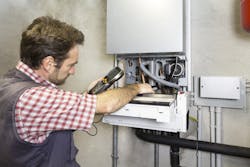The process of heating system replacement begins with a complete and thorough review of not just the boiler room and its components, but also the distribution system, the buildings control systems, and interviews with some of the buildings occupants and operators (management).
I generally start my review in the mechanical room by focusing on what is there and how it operates. Ideally, being able to show up when it’s good and cold outside will give you an idea about physical plant sizing, and its operation, but one must use caution. If you saw a lot of open windows when you first pulled up to the job site, the run time of the boilers may not take into consideration proper operating conditions. If most of the windows are closed, then it’s fairly safe to take the boilers burner run times into consideration as it pertains to the degree of cold weather exposure that the subject building is being exposed to.
Note whether the boiler burners are single stage or two stage, and obviously the BtuH input of the appliances at the various stages. These numbers will come in handy later on when you are doing due diligence as it pertains to heat loss calculations. It is strongly advised that, regardless of staging, the subject appliances be tested for combustion efficiency. Simple things like building stack height and improper barometric damper adjustments can contribute to poor thermal efficiency operations at the energy source regardless of what is going on in the balance of the system.
There are a plethora of inexpensive data loggers available that can be used to record these critical operating parameters.
For example, a boiler might be rated for 80% spontaneous thermal efficiency (not to be confused with seasonal efficiency) but that is based on 100% burner operation. If the appliance has a LOW burner input that is 1/3 of the total input, its spontaneous thermal efficiency is most probably significantly less than the 80% efficiency shown on the label due to excess air being drawn through the combustion process. Even in situations where the barometric damper is perfectly adjusted, due to a building’s tall stack height, excess air can severely degrade the appliances spontaneous and seasonal operating efficiencies.
Through diligent observation, you will discover that the boiler spends most of its time operating on its low burner position, further contributing to the waste of energy. Such is the nature of the beast. Even if the boiler is either designed for single stage operation or has its burner controls improperly adjusted to cause it to operate in a single stage configuration, the appliance will short cycle, which is also not good for overall thermal efficiency. This problem of short cycling is compounded even further if the burner connected to the appliance is a power burner with a pre and post burner purge configuration. Now instead of dealing with the natural draft tendencies, you have a large fan that, during pre and post burn purge cycles, is effectively extracting heat out of the appliance and sending to the great outdoors.
Whenever possible, setting data loggers to observe the operation of the burners for a minimum of a 24 hour period during an decent exposure to cold weather will at least give you and the building owner the opportunity to see how over or undersized the physical plant is in relation to the connected loads. The parameters that would need to be watched and recorded are: outside air temperature, boiler water supply and return temperature, real time burner operation (in both low and high burn configurations) and any non space heating load calls. Some systems also provide DHW, or snowmelt which needs to be taken into consideration for evaluation purposes.
This information will come in extremely handy when it becomes time to select the replacement appliance size in the next phase of evaluation. There are a plethora of inexpensive data loggers available that can be used to record these critical operating parameters and will allow you to make a professional presentation that will blow the socks off of your alleged competition when it comes time to make your presentation to the owners and/or the utility that might be subsidizing the replacement costs. These people love data and charts.
Quite honestly, in my 44 years of doing these replacements, I have never seen a system that was undersized. Tune in next month as we continue our journey and study for proper system replacement. Until then, Happy Spring hydronicing. Boiler replacement season is just around the corner!
Mark Eatherton material, in print and online, is protected by Copyright 2017. Any reuse of this material (print or electronic) must first have the express written permission of Mark Eatherton and CONTRACTOR magazine. Please contact via email at [email protected].
About the Author
Mark Eatherton
Mark Eatherton material on this website is protected by Copyright 2017. Any reuse of this material (print or electronic) must first have the expressed written permission of Mark Eatherton and CONTRACTOR Magazine.
